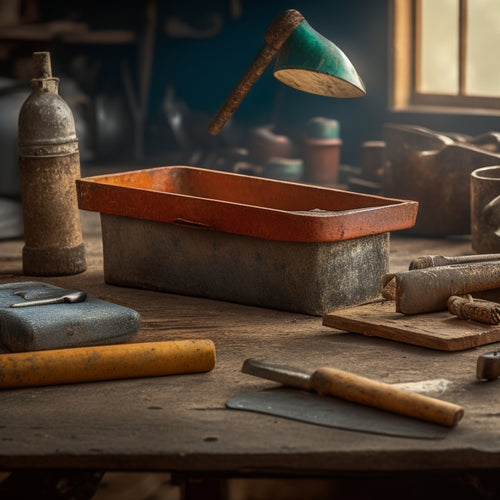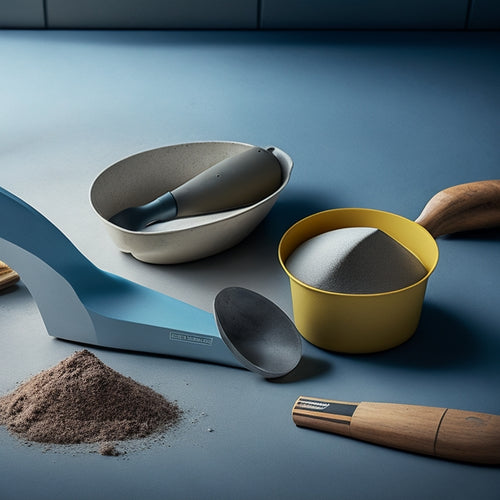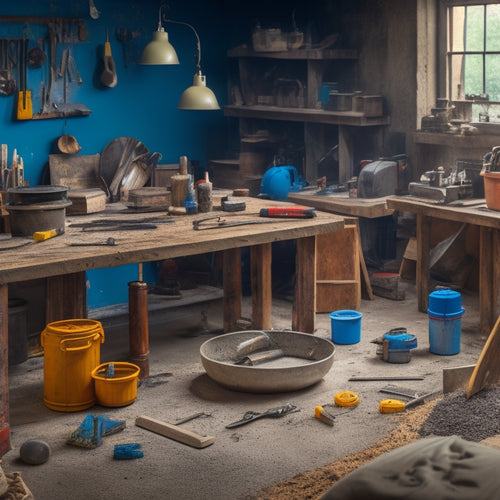
Top Hand Tools for Perfect Concrete Finishing
Share
You'll need a range of hand tools to achieve a perfect, polished concrete finish. Start with essential trowels like bull floats, darbies, and finishing trowels, each serving a specific stage in the finishing process. Edgers help define concrete borders, while finishing tools like textured rollers and surface stencils create unique textures. Hand floats, tamping tools, and concrete scrapers help level, compact, and smooth the surface. Specialty tools for decorative finishes and precision tools for detailed work can also elevate your project. By mastering these tools and techniques, you'll reveal the secrets to a flawless, professional-grade concrete finish - and discover the finer points that set exceptional work apart.
Key Takeaways
• Essential trowels, including bull float, darby, and finishing trowels, are necessary for achieving a smooth, even concrete finish.
• Edgers, such as edge profile selection, border control options, and material compatibility, help create defined concrete borders.
• Finishing tools, like textured rollers, surface stencils, and specialized trowels, enable the creation of textured surfaces with unique patterns.
• Hand floats, chosen based on concrete type, surface finish, and tool comfort, are crucial for leveling and smoothing concrete surfaces.
• Precision tools, including micro-measuring calipers, dental tools, and precision engraving tools, allow for detailed work and exceptional finishing.
Essential Trowels for Smooth Finishes
When it comes to achieving a smooth, even finish in concrete, you'll rely heavily on a trio of essential trowels that help you manipulate and refine the surface with precision and control.
These trowels are designed for specific stages of the finishing process, and mastering their uses is vital for achieving a high-quality finish.
You'll start with a bull float trowel, which helps to level and smooth out the concrete immediately after pouring.
As the concrete begins to set, you'll switch to a darby trowel, which refines the surface and removes any imperfections.
Finally, a finishing trowel comes into play, allowing you to achieve a smooth, even finish with precise control.
By mastering these trowel types and finishing techniques, you'll be able to produce a high-quality concrete finish that meets your project's requirements.
Edgers for Defined Concrete Borders
As you work on creating defined concrete borders, you'll need to contemplate the type of edge profile you want to achieve and the best edger to get the job done.
You'll have to decide between rounded, chamfered, or squared edges, and choose an edger that can produce the desired result.
Border Control Options
You'll achieve crisp, defined concrete borders by selecting the right edger from a range of border control options, each designed to tackle specific challenges and deliver precise results.
When it comes to border styles, you'll need to contemplate the type of border material you're working with. For instance, if you're working with a decorative concrete border, you'll want an edger that can handle intricate designs and patterns.
To achieve professional-looking results, you'll want to choose an edger that's specifically designed for your border material. Here are a few things to keep in mind:
-
Concrete edgers with adjustable handles allow for better control and precision when working with curved or irregular borders.
-
Edgers with replaceable blades are ideal for working with abrasive materials like exposed aggregate or decorative stone.
-
High-carbon steel edgers provide strength and durability when working with thick or dense border materials.
Edge Profiling Techniques
With your border material and edger selected, it's time to focus on edge profiling techniques that bring your defined concrete borders to life. Edge profiling is a vital step in achieving a professional-looking finish. You'll want to take into account the type of edge shaping you want to achieve, as it will impact the overall aesthetic of your concrete project.
Here are some common edge profiling techniques to take into account:
| Edge Profiling Technique | Description |
|---|---|
| ** Standard Edge ** | A clean, straight edge suitable for most concrete projects |
| ** Radius Edge ** | A curved edge for a softer, more rounded look |
| ** Beveled Edge ** | An angled edge that adds visual interest and depth |
| ** Decorative Edge ** | A custom edge design that adds a unique touch to your project |
When designing your edge profile, think about factors such as the type of concrete, the edger you're using, and the overall style you're aiming for. By selecting the right edge profiling technique, you'll be able to create defined concrete borders that elevate your project from ordinary to exceptional.
Finishing Tools for Textured Surfaces
When working on textured surfaces, you need specialized finishing tools that can effectively compress and smooth out the material without compromising its texture.
Textured surfaces require a different approach than smooth surfaces, and using the right tools is essential to achieve the desired finish.
To achieve a high-quality textured finish, you'll need tools that can effectively manipulate the concrete without leaving marks or defects. Here are some important tools to have in your arsenal:
-
Textured rollers: These rollers feature a unique pattern of nodules or bumps that help to create a uniform texture on the surface of the concrete.
-
Surface stencils: These stencils allow you to create intricate patterns and designs on the concrete surface, adding an extra layer of visual interest to your finished product.
-
Specialized trowels: These trowels have been designed specifically for working with textured surfaces, and feature unique blade shapes and angles that help to compress and smooth the concrete without leaving marks or defects.
Hand Floats for Leveling Concrete
When you're working with hand floats for leveling concrete, you'll need to take into account several key factors to achieve a smooth, even finish.
You'll have to choose the right float for your specific job, prepare the concrete surface properly, and master the techniques required to get the job done efficiently.
Float Selection Criteria
You'll need to contemplate several key factors when choosing a hand float for leveling concrete, including the type of concrete, surface finish desired, and your personal comfort level with the tool's weight and size. The right float can make all the difference in achieving a smooth, even finish.
When it comes to float materials, you'll typically choose between magnesium, aluminum, or resin. Magnesium floats are ideal for rough, porous concrete, while aluminum floats are better suited for smoother surfaces. Resin floats are a good all-around option, but may not be as durable as the other two.
Consider the following factors when selecting a float:
-
Float sizes: Choose a float that matches the size of your concrete pour to guarantee efficient coverage.
-
Weight and balance: A well-balanced float with a comfortable weight will reduce fatigue and improve control.
-
Handle material and grip: A durable handle with a comfortable grip will help you maintain control and precision.
Concrete Surface Preparation
Preparing the concrete surface prior to finishing is essential, and that's where hand floats come in, allowing you to level and smooth out the concrete to achieve the desired finish.
You'll want to verify the surface is even, clean, and free of debris, as any imperfections will be magnified during the finishing process. To accomplish this, you'll need to employ effective surface preparation techniques, including substrate assessment methods to identify any cracks, unevenness, or weaknesses in the concrete.
Hand floats are perfect for this task, as they allow you to subtly manipulate the surface, filling in small gaps and imperfections. By working the float in a circular motion, you can create a uniform, even surface that's ideal for finishing.
Leveling Techniques Mastery
Mastering leveling techniques with hand floats is vital for achieving a uniform concrete surface, as it enables you to make precise adjustments to the slab's elevation and pitch. By using hand floats, you can refine your screed techniques and guarantee a smooth, even finish. To get the most out of your hand floats, it's important to understand the different leveling methods and when to apply them.
Here are some key considerations to keep in mind:
-
Float direction: Always float in a direction perpendicular to the screed board to prevent creating waves or swirls in the concrete.
-
Pressure control: Apply consistent, even pressure to the float to avoid creating low or high spots.
-
Overlap technique: Overlap your float strokes by about 50% to ensure a seamless blend between passes.
Tamping Tools for Compacting Mix
With concrete freshly poured, tamping tools are vital for compacting the mix to eliminate air pockets and secure a strong, even finish.
You'll want to master tamping techniques to achieve ideal compaction. There are various compaction methods to choose from, including handheld tampers, plate compactors, and spiked rollers. Handheld tampers are perfect for small areas and tight spaces, while plate compactors are better suited for larger areas. Spiked rollers provide extra force for dense compaction.
When selecting a tamping tool, consider the size and type of your project. For example, a handheld tamper is perfect for compacting small areas, such as around obstructions or in tight corners. A plate compactor, on the other hand, is better suited for larger areas, like sidewalks or driveways.
Regardless of the tool you choose, proper technique is essential. Use a consistent, overlapping pattern to guarantee thorough compaction. Apply gentle to moderate pressure, depending on the tool and mix design.
Concrete Scrapers for Removing Excess
How do you efficiently remove excess concrete from your freshly poured surface, ensuring a smooth finish and preventing imperfections? The answer lies in using the right concrete scrapers, made from high-quality materials such as stainless steel, aluminum, or fiberglass. These materials provide the necessary durability and flexibility to effectively scrape away excess concrete without damaging the surface.
When choosing a scraper, consider the size and shape of the blade, as well as the handle material and ergonomics. A comfortable grip and balanced design will reduce fatigue and improve your overall scraping technique.
To get the most out of your scraper, remember these key points:
-
Always scrape in a consistent, even motion, following the direction of the pour.
-
Apply gentle to moderate pressure, depending on the amount of excess concrete.
-
Use a scraper with a curved or angled blade to reach into corners and tight spaces.
Specialty Tools for Decorative Finishes
Achieving intricate, high-end decorative finishes requires utilizing specialized tools that can create unique textures, patterns, and effects on your freshly poured concrete surface.
You'll need tools that can help you achieve specific designs, such as stamped patterns, that mimic natural stone or wood. For instance, you can use texture mats or stamping tools to create realistic stone or brick patterns. These tools allow you to imprint patterns onto the concrete, giving it a unique, high-end look.
To take your decorative finishes to the next level, you may also want to evaluate acid staining tools. Acid staining involves applying a chemical stain to the concrete to create unique, mottled patterns.
You'll need specialized tools, such as acid-resistant brushes and applicators, to apply the stain evenly and achieve the desired effect.
By investing in these specialty tools, you'll be able to create stunning, one-of-a-kind decorative finishes that set your work apart.
With the right tools and a little creativity, you can transform ordinary concrete into an extraordinary work of art.
Precision Tools for Detailed Work
When tackling intricate concrete details, such as engravings, inlays, or small-scale textures, you'll need precision tools that allow for exacting control and finesse. These tools are designed to provide precision measurement and intricate detailing, enabling you to achieve the desired level of accuracy and precision in your work.
Some essential precision tools for detailed work include:
-
Micro-measuring calipers: for precise measurement of small concrete features
-
Dental tools: for intricate carving and shaping of concrete details
-
Precision engraving tools: for creating fine lines and patterns in concrete
With these precision tools, you'll be able to achieve a level of detailing that would be impossible with larger, more general-purpose tools.
By investing in these specialized tools, you'll be able to take your concrete finishing skills to the next level and produce work that's truly exceptional.
Whether you're working on a small decorative feature or a large commercial project, precision tools are an essential part of your toolkit.
Frequently Asked Questions
How Do I Prevent Rust From Forming on My Concrete Finishing Tools?
To prevent rust from forming on your tools, you'll want to prioritize rust prevention through regular tool maintenance, such as cleaning and drying them thoroughly, applying a rust-inhibiting coating, and storing them in a dry place.
What Is the Ideal Way to Clean and Store Hand Tools After Use?
"Guess what? You're still stuck with rusty tools because you didn't clean them properly! Learn from your mistake: wipe tools clean, dry thoroughly, and store in airtight containers or hang them up - proper tool maintenance and storage solutions will save you the headache."
Can I Use the Same Tools for Both Indoor and Outdoor Concrete Projects?
You can use some hand tools for both indoor and outdoor concrete projects, but consider the demands of each environment; indoor versatility requires precision, while outdoor durability demands ruggedness and corrosion resistance.
How Often Should I Replace Worn-Out or Damaged Hand Tools?
You should establish a replacement schedule for worn-out or damaged hand tools to maintain peak performance and safety. Regular tool maintenance helps identify worn parts, and replacing them every 6-12 months guarantees you're working efficiently and effectively.
Are There Any Safety Precautions I Should Take When Using Hand Tools on Concrete?
When working with hand tools on concrete, you should prioritize tool handling and injury prevention by wearing protective gear, maintaining a secure grip, and keeping your work area clear to minimize the risk of accidents.
Conclusion
You've spent hours mixing and pouring concrete, but it's the finishing touches that make all the difference. A sloppy finish can ruin an entire project, while a flawless one elevates it to perfection.
Don't let your hard work go to waste - arm yourself with the right hand tools to achieve a showroom shine. With these top tools, you'll be the master of smooth, textured, and decorative concrete finishes that will leave others in awe.
Related Posts
-

Smart Guide to Buying Used Concrete Hand Tools
You're about to buy used concrete hand tools, and you need to get it right. Dedicate time to identify the tools you n...
-

Ergonomic Concrete Tools for Tight Spaces
When you're tackling concrete work in tight spaces, ergonomic tools are your best bet for comfort and efficiency. The...
-

Budget-Friendly Tools for DIY Decorative Concrete Profiling
You can achieve professional-grade decorative concrete results on a budget by investing in the right combination of e...


